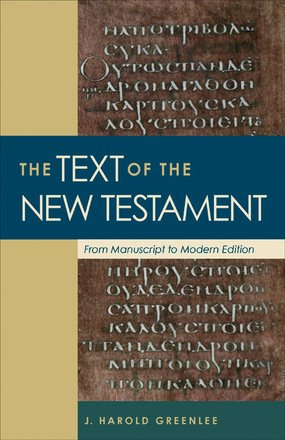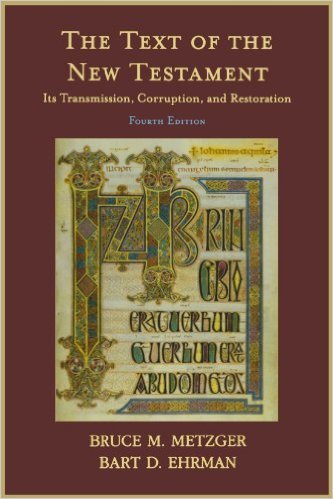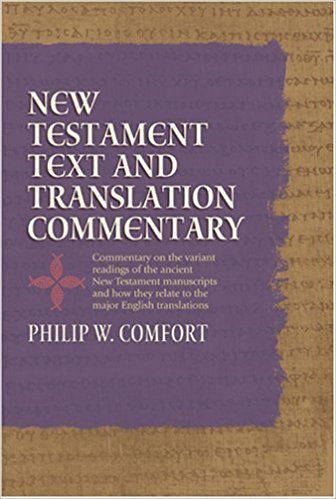|
Our focus in this section is the Greek MS (manuscript) translations of the Messianic Scriptures or the New Testament (NT) as these are the best known and are almost exclusively those employed in most English language translations.
A scholastic collation of earlier Aramaic and Hebrew MSS (manuscripts) as used in some messianic versions, which is still in its infancy, awaits much further work. While we hesitate, because of the compartively few studies, to recommend any particular New Testament MS studies, Andrew Gabriel Roth's, Aramaic English New Testament (Netsari Press: 2012) and James Scott Trimm's, Hebraic Roots Version Scriptures (SANJ: 2004) are good places to start. Most messianic versions (like the ISRV, CJB/JNT, Hallelujah Scriptures and OJB) use Greek NT MSS.
Numerous Bible versions provide extensive footnotes showing various MSS variations. Two of our favourites are, The New Interpreter's Study Bible - New Revised Standard Version With the Apocrypha (Abingdon Press: 2003) and ESV Study Bible - English Standard Version (Crossway: 2011).
1
 J. Harold Greenlee, The Text of the New Testament is a brief introduction for the lay person into the process whereby the New Testament came to be. It describes the basics of ancient writing tools, manuscripts, the work of scribes, and how to think about differences in what the various manuscripts say. This is a revised and expanded edition with a completely new chapter on how contemporary English translations fit in with our understanding of the New Testament text. Geared to the lay person who is uninformed or confused about textual criticism, Greenlee begins this volume by explaining the production of ancient manuscripts. He then traces the history of the development of the New Testament text. Readers are next introduced to the basic principles of textual criticism, the concept of variant readings, and how to determine which variant has the greatest likelihood of being the original reading. To illustrate the basic principles, several sample New Testament texts are examined. The book concludes by putting textual criticism in perspective as involving only a minute portion of the entire New Testament text, the bulk of which is indisputably attested by the manuscripts. (Reference)
J. Harold Greenlee, The Text of the New Testament is a brief introduction for the lay person into the process whereby the New Testament came to be. It describes the basics of ancient writing tools, manuscripts, the work of scribes, and how to think about differences in what the various manuscripts say. This is a revised and expanded edition with a completely new chapter on how contemporary English translations fit in with our understanding of the New Testament text. Geared to the lay person who is uninformed or confused about textual criticism, Greenlee begins this volume by explaining the production of ancient manuscripts. He then traces the history of the development of the New Testament text. Readers are next introduced to the basic principles of textual criticism, the concept of variant readings, and how to determine which variant has the greatest likelihood of being the original reading. To illustrate the basic principles, several sample New Testament texts are examined. The book concludes by putting textual criticism in perspective as involving only a minute portion of the entire New Testament text, the bulk of which is indisputably attested by the manuscripts. (Reference)
2
 Bruce M. Metzger & Bart D. Ehrman, The Text of the New Testament: It's Transmission, Corruption and Restoration (OUP: 2005) is the thoroughly revised edition of Bruce M. Metzger's classic work is the most up-to-date manual available for the textual criticism of the New Testament. The Text of the New Testament, Fourth Edition, has been invigorated by the addition of Bart D. Ehrman--author of numerous best-selling books on the New Testament--as a coauthor. This revision brings the discussion of such important matters as the early Greek manuscripts and methods of textual criticism up to date, integrating recent research findings and approaches into the body of the text (as opposed to previous revisions, which compiled new material and notes into appendices). The authors also examine new areas of interest, including the use of computers in the collection and evaluation of manuscript evidence and the effects that social and ideological influences had upon the work of scribes. The standard text for courses in biblical studies and the history of Christianity since its first publication in 1964, The Text of the New Testament is poised to become a definitive resource for a whole new generation of students. (Reference)
Bruce M. Metzger & Bart D. Ehrman, The Text of the New Testament: It's Transmission, Corruption and Restoration (OUP: 2005) is the thoroughly revised edition of Bruce M. Metzger's classic work is the most up-to-date manual available for the textual criticism of the New Testament. The Text of the New Testament, Fourth Edition, has been invigorated by the addition of Bart D. Ehrman--author of numerous best-selling books on the New Testament--as a coauthor. This revision brings the discussion of such important matters as the early Greek manuscripts and methods of textual criticism up to date, integrating recent research findings and approaches into the body of the text (as opposed to previous revisions, which compiled new material and notes into appendices). The authors also examine new areas of interest, including the use of computers in the collection and evaluation of manuscript evidence and the effects that social and ideological influences had upon the work of scribes. The standard text for courses in biblical studies and the history of Christianity since its first publication in 1964, The Text of the New Testament is poised to become a definitive resource for a whole new generation of students. (Reference)
3
 Philip W. Comfort, New Testament Text and Translation Commentary is especially useful for pastors and teachers who know that the members of their audiences use a variety of different English versions. It is also a helpful tool for serious students of the Bible, including laypeople and seminary students. In addition to this passage-by-passage commentary, the reader is introduced to the art of textual criticism, its importance for studying the New Testament, and the challenges translators of English versions face. Philip W. Comfort surveys and tabulates all the major English translations in a clear, easy to read manner. In the Logos edition, this volume is enhanced by amazing functionality. Important terms link to dictionaries, encyclopedias, and a wealth of other resources in your digital library. Perform powerful searches to find exactly what you’re looking for. Take the discussion with you using tablet and mobile apps. With Logos Bible Software, the most efficient and comprehensive research tools are in one place, so you get the most out of your study. (Reference) Philip W. Comfort, New Testament Text and Translation Commentary is especially useful for pastors and teachers who know that the members of their audiences use a variety of different English versions. It is also a helpful tool for serious students of the Bible, including laypeople and seminary students. In addition to this passage-by-passage commentary, the reader is introduced to the art of textual criticism, its importance for studying the New Testament, and the challenges translators of English versions face. Philip W. Comfort surveys and tabulates all the major English translations in a clear, easy to read manner. In the Logos edition, this volume is enhanced by amazing functionality. Important terms link to dictionaries, encyclopedias, and a wealth of other resources in your digital library. Perform powerful searches to find exactly what you’re looking for. Take the discussion with you using tablet and mobile apps. With Logos Bible Software, the most efficient and comprehensive research tools are in one place, so you get the most out of your study. (Reference)
|


